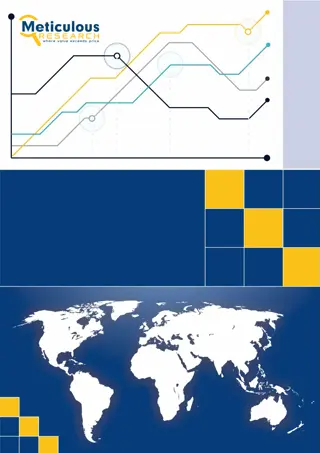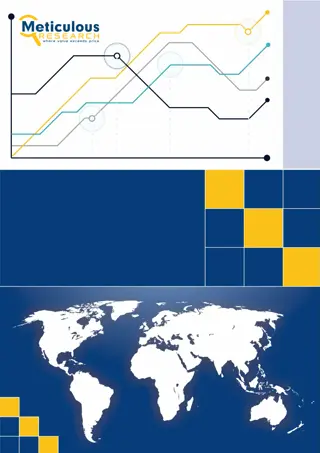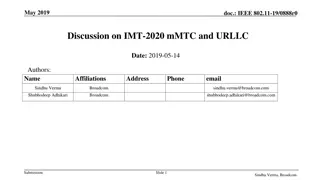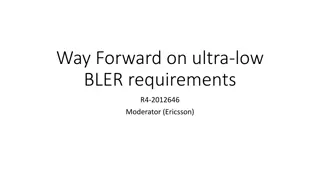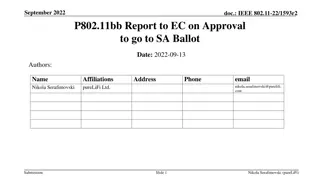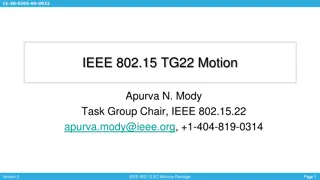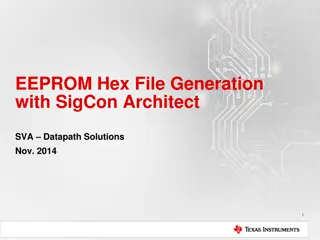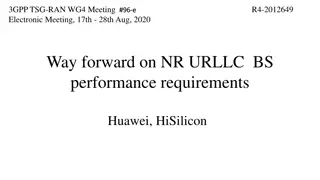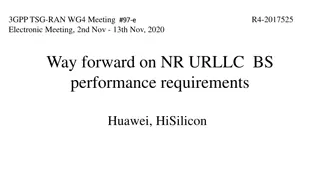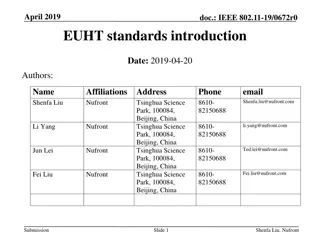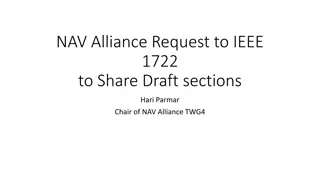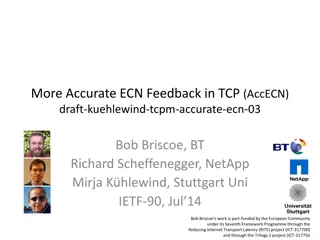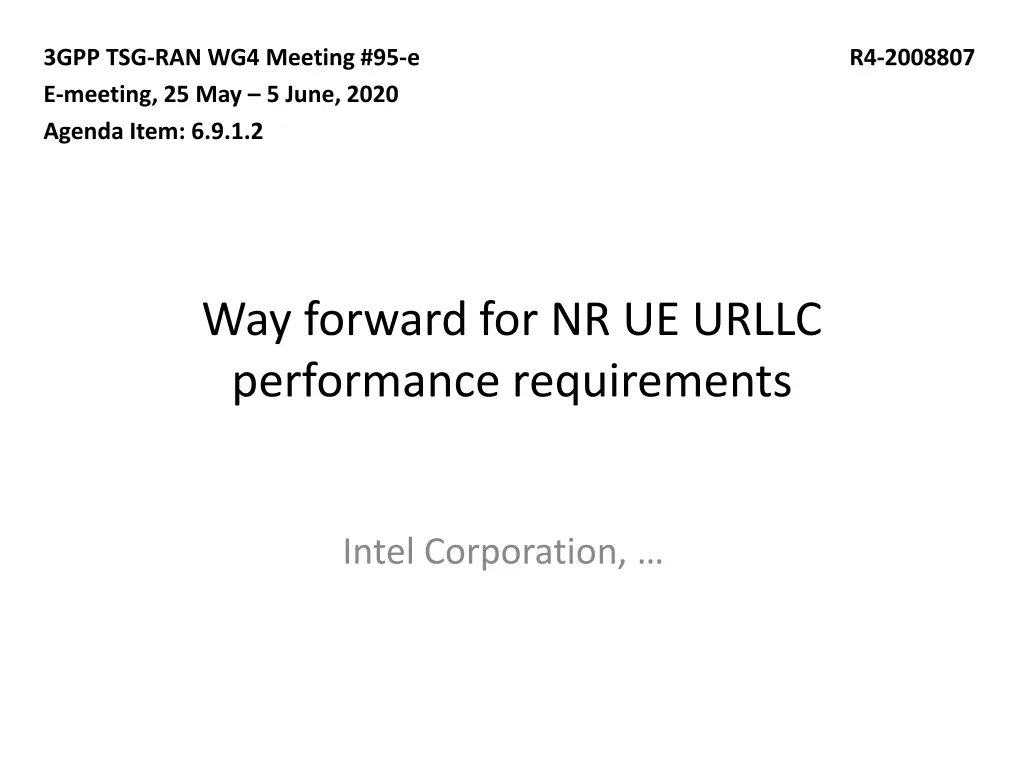
NR UE URLLC Performance Requirements Overview
Explore the detailed agenda items and discussions from the 3GPP TSG-RAN WG4 Meeting #95-e regarding the way forward for NR UE URLLC performance requirements set by Intel Corporation. The meeting covers aspects like high reliability parameters, scheduling for PDSCH, and PDSCH mapping types and processing capabilities for FDD and TDD scenarios. Dive into the technical details and proposed solutions for enhancing performance in 5G networks.
Download Presentation

Please find below an Image/Link to download the presentation.
The content on the website is provided AS IS for your information and personal use only. It may not be sold, licensed, or shared on other websites without obtaining consent from the author. If you encounter any issues during the download, it is possible that the publisher has removed the file from their server.
You are allowed to download the files provided on this website for personal or commercial use, subject to the condition that they are used lawfully. All files are the property of their respective owners.
The content on the website is provided AS IS for your information and personal use only. It may not be sold, licensed, or shared on other websites without obtaining consent from the author.
E N D
Presentation Transcript
3GPP TSG-RAN WG4 Meeting #95-e E-meeting, 25 May 5 June, 2020 Agenda Item: 6.9.1.2 R4-2008807 Way forward for NR UE URLLC performance requirements Intel Corporation,
High reliability (1) Background (Agreed parameters from #94e and #94e-Bis) SCS/CBW: FDD: 15 kHz/10 MHz TDD: 30 kHz/40 MHz TDD pattern: 7D1S2U, S=6D: 4G: 4U for 30 kHz SCS. PDSCH configuration: Mapping type A, symbol length 12, starting symbol 2. PDSCH Aggregation level: 2 for FDD and TDD Max number of HARQ transmissions: 4 Antenna configuration: 2x2 and 2x4, ULA low Propagation condition: TDLA30-10 Target BLER: 1% (BLER is calculated after all transmission ) Target Confidence level: 99% 2
High reliability (2) Scheduling for PDSCH: FDD: No scheduling in slots 0 and 1 (or 19) within 20ms. TDD: No scheduling in D slots i, where mod(i, 10) = 0, and S slots MCS: Option 1: MCS13 Option 2: MCS16 Option 3: MCS19 MCS will be selected based on impairment simulation results from companies to ensure that SNR for 2Rx requirements is not less than -1 dB and SNR for 4Rx requirements is not less than -4 dB Note: -1 dB and -4 dB are the lower bounds of existing Rel-15 requirements FR2 requirements for High reliability FFS whether to define FR2 requirements Interested companies are encouraged to bring more information and analysis for the deployment/usage scenarios The performance requirements will be introduced for FR2, FFS for test applicable rules 3
PDSCH mapping Type B and processing capability 2 (1) Background (Agreed parameters from #94e and 94e-bis) SCS/CBW: FDD: 15 KHz/10 MHz TDD: 30 KHz/ 40 MHz TDD pattern (30KHz SCS): DDDSU, S=10:2:2 Slots to be scheduled: FDD: All DL slots with K1=0 TDD: S slots with K1=0 Starting symbol: 2 Symbol length: 2 Slot aggregation level: 1 Max number of HARQ transmissions: 1 Number of HARQ process for FDD: 2 Channel model: TDLA30-10 Antenna configuration: 2x2 and 2x4, ULA Low. 4
PDSCH mapping Type B and processing capability 2 (2) PDSCH symbol length for FDD and TDD: 2os only Test metrics: 70% throughput Number of HARQ process for TDD: Option 1: 2 Option 2: 4 processes and PDSCH scheduling with HARQ index 3 MCS: Option 1: Only MCS 4 Option 2: Only MCS 17 Option 3: MCS 4 and MCS 17 FR2 requirements for PDSCH mapping Type B and processing capability 2 FFS whether to define FR2 requirements Interested companies are encouraged to bring more information and analysis for the deployment/usage scenarios Agreement: Introduce test cases for FR2, FFS whether test applicable rules will be introduced. 5
Pre-emption indication (1) Background (Agreed parameters from #94e) No URLLC PI performance requirements Time frequency set: 14x1 Number of symbols to be pre-empted: 2 Starting symbol to be pre-empted: 3 Test applicability for eMBB UE PI requirements: optional with UE capability signalling Antenna Configuration: 2x2 and 2x4, ULA low 6
Pre-emption indication (2) Pre-emption scheduling: Fixed scheduling Pre-emption probability Option 1: 10% within 1 radio frame Option 2: 20% within 1 radio frame eMBB MCS Option 1: MCS13 in Table 1 Option 2: MCS4 in Table 1 Test metric Option 1: 70% of max T-put Other options are not precluded Companies are encouraged to prepare comparison analysis of UE with and without HARQ buffer flushing of pre-empted bits to decide on options above 7
Pre-emption indication (3) Use the following parameters for eMBB PDSCH configuration Parameter Value FDD, TDD 1 Type A 0 2 12 1 Static 2 Type 0 Config2 Non-interleaved Duplex mode Active DL BWP index Mapping type k0 Starting symbol (S) Length (L) PDSCH aggregation factor PRB bundling type PRB bundling size Resource allocation type RBG size VRB-to-PRB mapping type VRB-to-PRB mapping interleaver bundle size DMRS Type Number of additional DMRS Maximum number of OFDM symbols for DL front loaded DMRS PDSCH configuration N/A Type 1 1 PDSCH DMRS configuration 1 FDD: 4 TDD: 8 Number of HARQ Processes Maximum HARQ transmission 4 The number of slots between PDSCH and corresponding HARQ-ACK information and TDD pattern FDD: 2 TDD: FR1.30-1 FDD: 10/15 TDD: 40/30 Full bandwidth Rank 1 TDLA30-10 CBW/SCS RB allocation MIMO layer Propagation condition 8
CQI reporting requirements (1) Propagation channel for CQI reporting Option 1: AWGN Option 2: Fading channel Target BLER in case AWGN conditions will be used Option 1: 10^-5 Option 2: 10^-3 Option 3: 10^-2 9
CQI reporting requirements (2) Test metric in case AWGN conditions will be used Option 1: Reuse Rel-15 CQI test metric Option 2: Reuse Rel-15 CQI test metric and define a lower bound for median reported CQI in the CQI reporting tests for 99.999% reliability Other options are not precluded Test metric in case Fading conditions will be used Option 1: A CQI index not in the set {median CQI -1, median CQI, median CQI +1} shall be reported at least % of the time The ratio of the throughput with follow CQI vs median CQI shall be Other options are not precluded In case AWGN conditions with target BLER 10^-5 will be used, FFS feasibility to define CQI reporting test case and FMCS case at the same SNR and define an applicability rule between CQI reporting test and FMCS test 10

